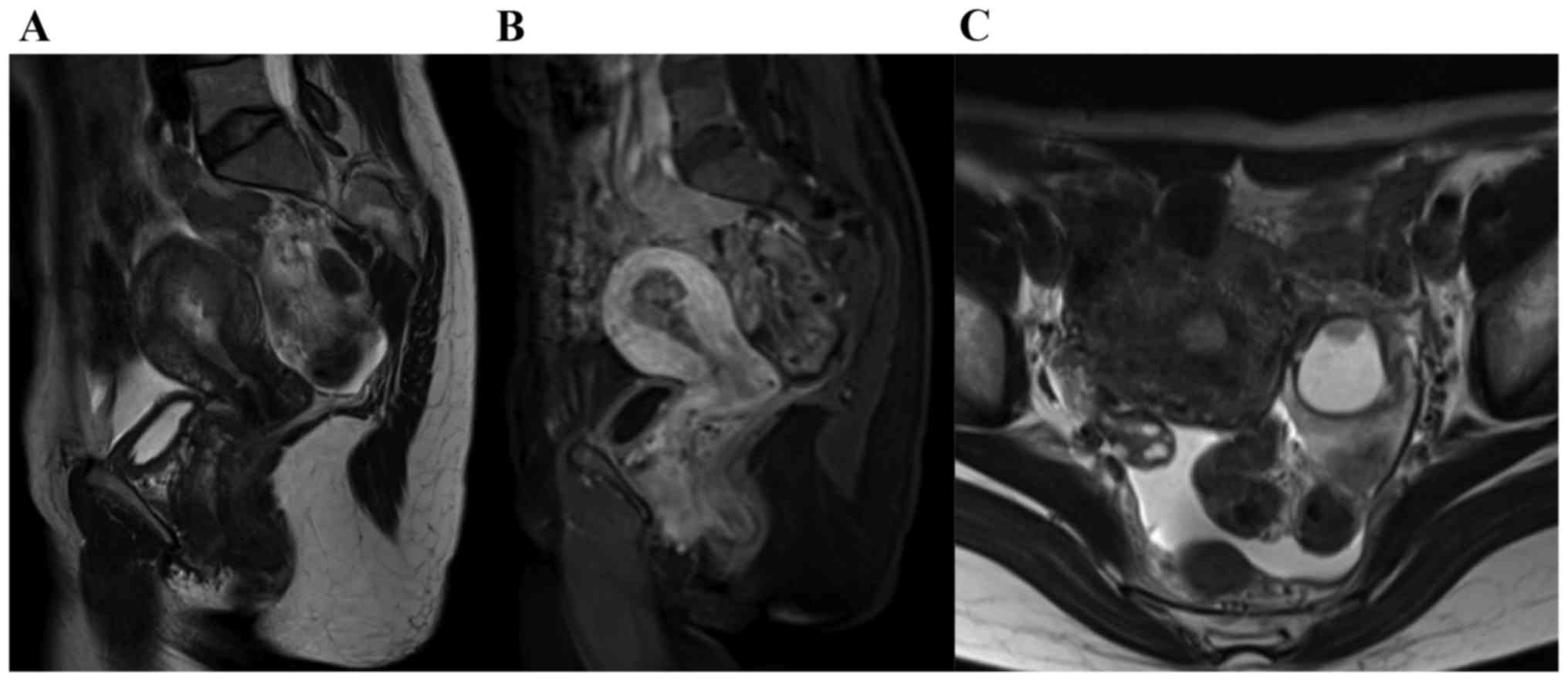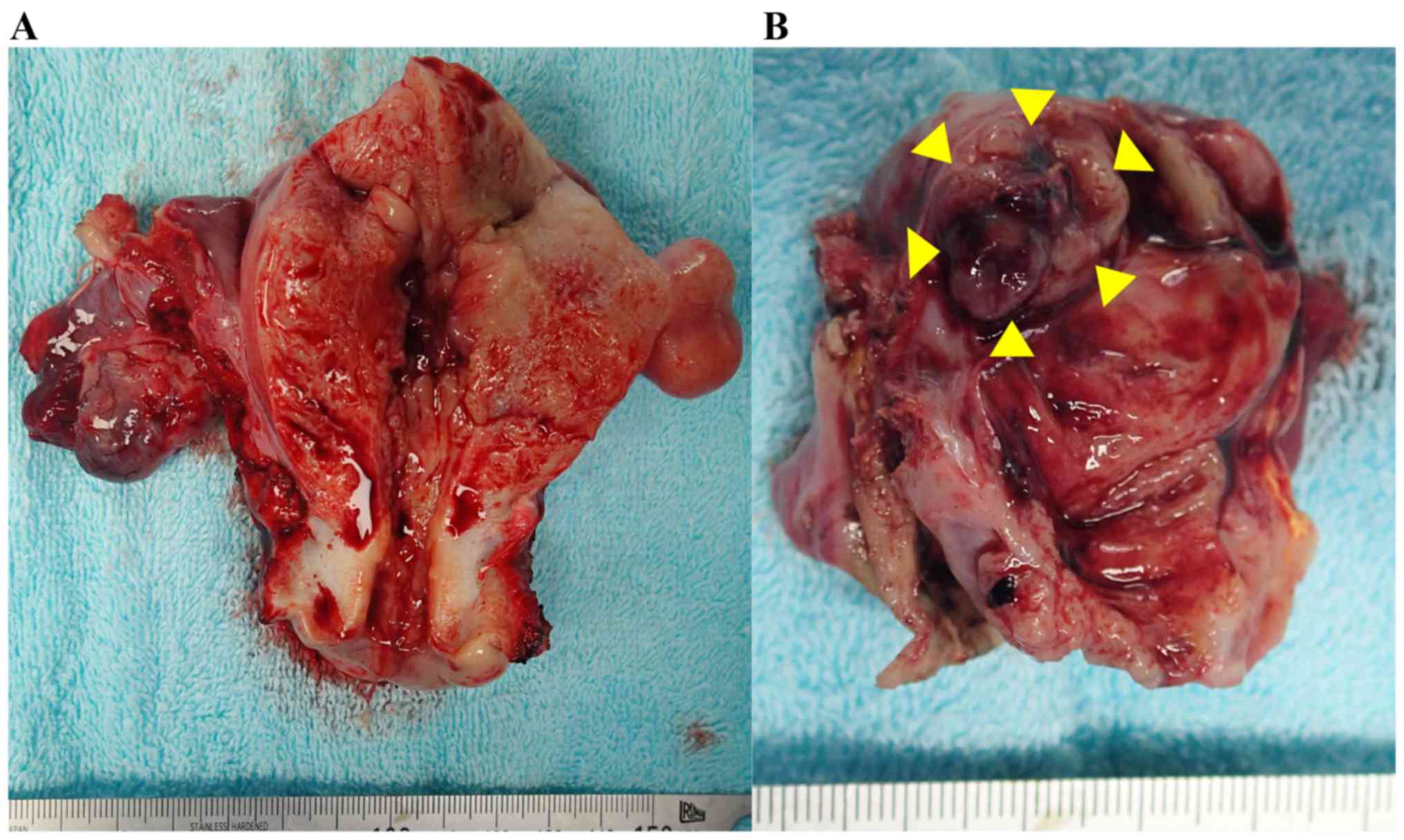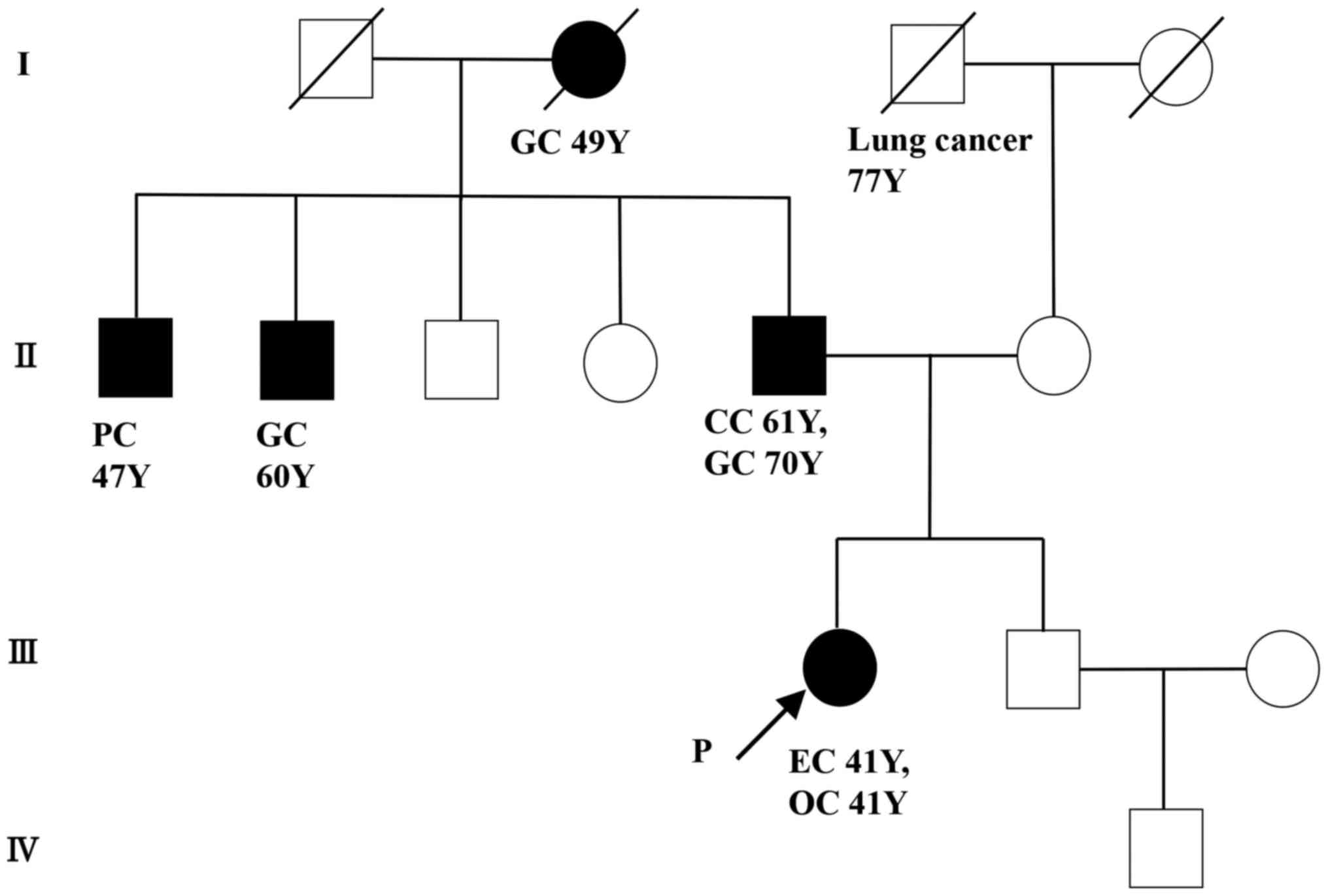Synchronous endometrial and ovarian cancer in Lynch syndrome with a MSH2 germline mutation: A case report
- Authors:
- Published online on: September 17, 2018 https://doi.org/10.3892/mco.2018.1723
- Pages: 479-484
Abstract
Introduction
Co-occurrence of carcinoma in the uterus and ovary is found in ~5% of cases of endometrial cancer and 10% of ovarian cancer (1,2). Synchronous endometrial and ovarian cancer (SEOC) accounts for 50–70% of all synchronous female genital cancers, and ~1–2% of all women with gynecological cancers have simultaneous primary tumors involving the genital tract (3,4). SEOC is usually diagnosed at its early stages, which results in a good prognosis (5,6). Another characteristic of SEOC is that both the endometrial and ovarian cancers have mainly endometrioid histology (2). In such cases, differential diagnoses include primary SEOC with stage I endometrioid endometrial cancer and endometrioid ovarian cancer, stage III metastatic endometrioid endometrial cancer to the ovary, and stage II metastatic endometrioid ovarian cancer to the endometrium. The Ulbright and Roth criteria are commonly used to distinguish SEOC from metastatic endometrial or ovarian cancer (7).
The correlation of Lynch syndrome with SEOC is not well understood. Several studies have reported that Lynch syndrome is not common in patients with SEOC, and it is estimated that ~3–14% of SEOC cases are caused by Lynch syndrome (8–10). By contrast, 17–30% of cases of synchronous or metachronous endometrial and colorectal cancers are caused by Lynch syndrome (11,12). However, the prevalence of Lynch syndrome in SEOC is more frequent compared with that in endometrial or ovarian cancer. Furthermore, a double primary Lynch-associated cancer with a family history shows a high prevalence of Lynch syndrome, and it is important to test for microsatellite instability (MSI) or expression of mismatch repair (MMR) proteins by immunohistochemistry (IHC) in such cases (13). We herein report a case of SEOC (endometrial endometrioid adenocarcinoma and ovarian mixed endometrioid and clear cell carcinoma) with a MSH2 mutation.
Case report
A 41-year-old woman with abnormal genital bleeding and hypermenorrhea was referred to the Department of Obstetrics and Gynecology of Keio University School of Medicine (Tokyo, Japan) from a gynecological outpatient clinic in May, 2016. The patient had anemia (hemoglobin 6.5 g/dl), and transvaginal ultrasonography revealed thickened (20 mm) endometrium and swelling (34 mm) of the left ovary with a solid component. The findings on cervical cytology were atypical glandular cells, favor neoplastic (AGC-FN), indicating contamination by endometrial cells, and endometrial cytology was positive, suggesting endometrioid adenocarcinoma. Endometrial curettage revealed endometrial endometrioid adenocarcinoma grade 2. The tumor markers carbohydrate antigen (CA) 19-9 and CA125 were elevated (118 and 52 U/ml, respectively; normal range: <37 and <35 U/ml, respectively), whereas the carcinoembryonic antigen level was normal (0.9 ng/ml). Positron emission tomography/computed tomography revealed no distant metastasis, but contrast-enhanced pelvic magnetic resonance imaging examination revealed invasion of over half of the thickness of the myometrium by endometrial cancer and enlargement of the left ovary to 30 mm with an enhanced solid component (Fig. 1). These findings indicated that the pelvic tumor was SEOC, or endometrial cancer with ovarian metastasis.
During surgery, the uterus and left ovary were grossly enlarged and there was no abdominal metastasis. A frozen section diagnosis of the left ovarian tumor revealed adenocarcinoma with a clear cell component, indicating primary ovarian cancer. Extended total hysterectomy, bilateral salpingo-oophorectomy, pelvic and para-aortic lymphadenectomy, omentectomy, and peritoneal biopsies were performed (Fig. 2). Surgery was completed without any complications or the need for blood transfusion, and the patient was discharged from the hospital 1 week after the operation.
The pathological findings included endometrial endometrioid adenocarcinoma G2 and ovarian mixed endometrioid and clear cell carcinoma. There was no metastasis to the omentum or peritoneum, but there were metastases to the right obturator and left para-aortic lymph nodes. Endometrial adenocarcinoma had invaded almost half of the myometrium and also exhibited lymphovascular invasion. Finally, the diagnosis was synchronous International Federation of Gynecology and Obstetrics (FIGO) stage IIIC2 endometrial endometrioid adenocarcinoma, and FIGO stage IA ovarian endometrioid and clear cell carcinoma (Table I). Due to the high risk of recurrence, adjuvant chemotherapy with paclitaxel (175 mg/m2) and carboplatin (area under the curve=6) was administered once every three weeks for six cycles. The patient is currently being followed up and remained recurrence-free at the most recent follow-up appointment in April, 2018.
The patient had a family history of colorectal and gastric cancers, as well as young onset of SEOC, and Lynch syndrome was suspected (Fig. 3). Therefore, MSI was analyzed for 5 markers (NR21, NR24, BAT25, BAT26, MONO27) and all were positive (MSI-high). IHC was performed for MLH1, MSH2, MSH6 and PMS2. All the cancer components (endometrial endometrioid adenocarcinoma, ovarian endometrioid carcinoma and ovarian clear cell carcinoma) exhibited loss of MSH2 and MSH6 expression (Fig. 4). These results indicated a MSH2 germline mutation or MSH2 epimutation due to an EPCAM mutation. Following detailed genetic counseling, we performed a genetic test for MMR genes, namely MLH1, MSH2, MSH6 and PMS2. reverse transcription-polymerase chain reaction (PCR) was performed, and the results were confirmed by direct sequencing using genomic DNA. Furthermore, we checked for a large rearrangement by multiplex ligation-dependent probe amplification (MLPA) for MLH1, MSH2, MSH6 and PMS2. Additionally, the methylation status of CpG islands in the MLH1, MSH2 and MSH6 promoters was analyzed by methylation-specific PCR. There was no large rearrangement, and methylation for tested genes and direct sequencing revealed a germline mutation in exon 6 of MSH2 (c.1042C>T, p.Gln348*), confirming the diagnosis of Lynch syndrome (Fig. 5).
Discussion
Lynch syndrome accounts for 2–6% of endometrial cancers and 0.4–1.0% of ovarian cancers (14,15). The cumulative lifetime risks of endometrial and ovarian cancer are ~28–60 and 6–14%, respectively, in female patients with Lynch syndrome (16–18). However, the risk of SEOC in the context of this syndrome is uncertain, although it has been suggested that ~3–14% of SEOC cases exhibit a causative association with Lynch syndrome (8–10). Synchronous or metachronous Lynch-associated cancer with a family history shows a high prevalence of Lynch syndrome (13), and our patient had SEOC with a family history of Lynch-associated cancers. The calculated risk of Lynch syndrome by the PREMM5 prediction model was 26.3%. The patient in the present case had an endometrioid carcinoma component in the endometrial and ovarian cancers, consistent with a previous report that SEOC tends to include endometrioid components in both cancers (2). The majority of clinically diagnosed SEOC cases also have clonally related cancers, which probably reflects dissemination from one site to the other (19,20). However, our patient had a clear cell component in the left ovarian cancer and a right ovarian borderline clear cell adenofibroma, which made it easy to diagnose the case as SEOC, rather than metastatic ovarian cancer.
Endometrial cancer with Lynch syndrome is mainly caused by a MSH2 or MSH6 mutation, whereas ovarian cancer with Lynch syndrome is mainly caused by a MSH2 mutation (21,22). It is also likely that MSH2 and MSH6 mutations may be the main cause of SEOC based on the frequency of these mutations in endometrial or ovarian cancer. Some reports have linked MLH1, MSH2 and MSH6 to SEOC, but the available data are limited (9,10,23). In addition, the only entries in the InSiGHT database registered for synchronous or metachronous endometrial and ovarian cancer are two MLH1 variants, two MLH3 variants, and one MSH6 variant (MLH1: c.1162dup, c.1852_1854del; MLH3: c.1939C>T, c.2449A>G; and MSH6: c.3632T>C) (https://www.insight-group.org/variants/databases/). The mutation detected in the present case (MSH2 exon6, c.1042C>T, p.Gln348*) is registered only for one case in InSiGHT, and this report did not mention the cancer origin (24). This mutation is not classified as either pathogenic or non-pathogenic in InSiGHT, but is classified as class 5 (pathogenic) in the original report (24). The mutation stops translation at position 348 of the 934 amino acids of MSH2, and this region serves as the MSH3/MSH6 interaction domain. Therefore, it appears to be appropriate to classify this mutation as pathogenic.
To the best of our knowledge, this is the first reported case of the c.1042C>T MSH2 mutation in a gynecological tumor or SEOC. Lynch syndrome in SEOC is not common, but is more often detected in SEOC compared with general endometrial cancer cases. Given that universal screening for endometrial cancer is becoming a standard practice and SEOC would be a high risk of Lynch syndrome, as stated in our previous report on screening for Lynch syndrome in ovarian cancer, it is necessary to perform MSI or IHC analysis for all SEOC cases (25,26). Detecting MSI-H in SEOC may be helpful for the diagnosis of Lynch syndrome, as well as for the use of precision medicine for ovarian or endometrial cancer, including targeted therapy of anti-PD1/PDL1 for MSI-H cancer. Furthermore, since the frequency and tendency for MMR gene mutation are not clear in SEOC, use of IHC for examination of loss of MMR protein expression may be informative in identifying the gene carrying the mutation.
Acknowledgements
The authors gratefully acknowledge the financial support and the support from the patient for publication of this report.
Funding
The present study was supported by the Keio Gijuku Academic Development Fund, the Keio University Grant-in-Aid for Encouragement of Young Medical Scientists and JSPS KAKENHI Grant-in-Aid for Young Scientists (JP18K16812).
Availability of data and materials
The datasets used during the present study are included in this published article and are also available from the corresponding author on reasonable request.
Authors' contributions
TakasT wrote the manuscript, K.B. checked the manuscript, MY performed tumor tests, MA, AK, AS and TakayT collected clinical data, MA, YK and AH contributed to genetic counseling, and HN, ET and DA supervised the study. All authors have read and approved the final version of this manuscript.
Ethics approval and consent to participate
The study was performed in accordance with the Declaration of Helsinki and principles of Good Clinical Practice. Samples and clinical data were obtained after approval of the Institutional Ethics Committee of Keio University (ID: 2007-0081). The patient provided written informed consent.
Patient consent for publication
This patient provided informed consent for the publication of the study details, including use of data and images.
Competing interests
The authors declare that they have no competing interests.
Glossary
Abbreviations
Abbreviations:
|
SEOC |
synchronous endometrial and ovarian cancer |
|
MMR |
mismatch repair |
|
MSI |
microsatellite instability |
|
IHC |
immunohistochemistry |
|
MLPA |
multiplex ligation-dependent probe amplification |
References
|
Kurman RJ, Carcangiu ML, Herrington CS and Young RH: WHO Classification of Tumours of Female Reproductive OrgansIARC WHO Classification of Tumours. International Agency for Research on Cancer; Lyon: 2014 | |
|
Zaino R, Whitney C, Brady MF, DeGeest K, Burger RA and Buller RE: Simultaneously detected endometrial and ovarian carcinomas-a prospective clinicopathologic study of 74 cases: A gynecologic oncology group study. Gynecol Oncol. 83:355–362. 2001. View Article : Google Scholar : PubMed/NCBI | |
|
Tong SY, Lee YS, Park JS, Bae SN, Lee JM and Namkoong SE: Clinical analysis of synchronous primary neoplasms of the female reproductive tract. Eur J Obstet Gynecol Reprod Biol. 136:78–82. 2008. View Article : Google Scholar : PubMed/NCBI | |
|
Singh N: Synchronous tumours of the female genital tract. Histopathology. 56:277–285. 2010. View Article : Google Scholar : PubMed/NCBI | |
|
Sozen H, Vatansever D, Iyibozkurt AC, Topuz S, Ozsurmeli M, Salihoglu Y, Guzelbey B and Berkman S: Clinicopathologic and survival analyses of synchronous primary endometrial and epithelial ovarian cancers. J Obstet Gynaecol Res. 41:1813–1819. 2015. View Article : Google Scholar : PubMed/NCBI | |
|
Matsuo K, Machida H, Frimer M, Marcus JZ, Pejovic T, Roman LD and Wright JD: Prognosis of women with stage I endometrioid endometrial cancer and synchronous stage I endometrioid ovarian cancer. Gynecol Oncol. 147:558–564. 2017. View Article : Google Scholar : PubMed/NCBI | |
|
Ulbright TM and Roth LM: Metastatic and independent cancers of the endometrium and ovary: A clinicopathologic study of 34 cases. Hum Pathol. 16:28–34. 1985. View Article : Google Scholar : PubMed/NCBI | |
|
Kobayashi Y, Nakamura K, Nomura H, Banno K, Irie H, Adachi M, Iida M, Umene K, Nogami Y, Masuda K, et al: Clinicopathologic analysis with immunohistochemistry for DNA mismatch repair protein expression in synchronous primary endometrial and ovarian cancers. Int J Gynecol Cancer. 25:440–446. 2015. View Article : Google Scholar : PubMed/NCBI | |
|
Kim MK, Song SY, Do IG, Kim SH, Choi CH, Kim TJ, Lee JW, Bae DS and Kim BG: Synchronous gynecologic malignancy and preliminary results of Lynch syndrome. J Gynecol Oncol. 22:233–238. 2011. View Article : Google Scholar : PubMed/NCBI | |
|
Soliman PT, Broaddus RR, Schmeler KM, Daniels MS, Gonzalez D, Slomovitz BM, Gershenson DM and Lu KH: Women with synchronous primary cancers of the endometrium and ovary: Do they have Lynch syndrome? J Clin Oncol. 23:9344–9350. 2005. View Article : Google Scholar : PubMed/NCBI | |
|
Millar AL, Pal T, Madlensky L, Sherman C, Temple L, Mitri A, Cheng H, Marcus V, Gallinger S, Redston M, et al: Mismatch repair gene defects contribute to the genetic basis of double primary cancers of the colorectum and endometrium. Hum Mol Genet. 8:823–829. 1999. View Article : Google Scholar : PubMed/NCBI | |
|
Planck M, Rambech E, Möslein G, Müller W, Olsson H and Nilbert M: High frequency of microsatellite instability and loss of mismatch-repair protein expression in patients with double primary tumors of the endometrium and colorectum. Cancer. 94:2502–2510. 2002. View Article : Google Scholar : PubMed/NCBI | |
|
Hirai Y, Banno K, Suzuki M, Ichikawa Y, Udagawa Y, Sugano K and Miki Y: Molecular epidemiological and mutational analysis of DNA mismatch repair (MMR) genes in endometrial cancer patients with HNPCC-associated familial predisposition to cancer. Cancer Sci. 99:1715–1719. 2008. View Article : Google Scholar : PubMed/NCBI | |
|
Norquist BM, Harrell MI, Brady MF, Walsh T, Lee MK, Gulsuner S, Bernards SS, Casadei S, Yi Q, Burger RA, et al: Inherited mutations in women with ovarian carcinoma. JAMA Oncol. 2:482–490. 2016. View Article : Google Scholar : PubMed/NCBI | |
|
Pal T, Permuth-Wey J, Kumar A and Sellers TA: Systematic review and meta-analysis of ovarian cancers: Estimation of microsatellite-high frequency and characterization of mismatch repair deficient tumor histology. Clin Cancer Res. 14:6847–6854. 2008. View Article : Google Scholar : PubMed/NCBI | |
|
Aarnio M, Sankila R, Pukkala E, Salovaara R, Aaltonen LA, de la Chapelle A, Peltomäki P, Mecklin JP and Järvinen HJ: Cancer risk in mutation carriers of DNA-mismatch-repair genes. Int J Cancer. 81:214–218. 1999. View Article : Google Scholar : PubMed/NCBI | |
|
Bonadona V, Bonaïti B, Olschwang S, Grandjouan S, Huiart L, Longy M, Guimbaud R, Buecher B, Bignon YJ, Caron O, et al: Cancer risks associated with germline mutations in MLH1, MSH2 and MSH6 genes in Lynch syndrome. JAMA. 305:2304–2310. 2011. View Article : Google Scholar : PubMed/NCBI | |
|
Watson P, Vasen HFA, Mecklin JP, Bernstein I, Aarnio M, Järvinen HJ, Myrhøj T, Sunde L, Wijnen JT and Lynch HT: The risk of extra-colonic, extra-endometrial cancer in the Lynch syndrome. Int J Cancer. 123:444–449. 2008. View Article : Google Scholar : PubMed/NCBI | |
|
Chao A, Wu RC, Jung SM, Lee YS, Chen SJ, Lu YL, Tsai CL, Lin CY, Tang YH, Chen MY, et al: Implication of genomic characterization in synchronous endometrial and ovarian cancers of endometrioid histology. Gynecol Oncol. 143:60–67. 2016. View Article : Google Scholar : PubMed/NCBI | |
|
Schultheis AM, Ng CK, De Filippo MR, Piscuoglio S, Macedo GS, Gatius S, Mies Perez B, Soslow RA, Lim RS, Viale A, et al: Massively parallel sequencing-based clonality analysis of synchronous endometrioid endometrial and ovarian carcinomas. J Natl Cancer Inst. 108:djv4272016. View Article : Google Scholar : PubMed/NCBI | |
|
Schweizer P, Moisio AL, Kuismanen SA, Truninger K, Vierumäki R, Salovaara R, Arola J, Butzow R, Jiricny J, Peltomäki P and Nyström-Lahti M: Lack of MSH2 and MSH6 characterizes endometrial but not colon carcinomas in hereditary nonpolyposis colorectal cancer. Cancer Res. 61:2813–2815. 2001.PubMed/NCBI | |
|
Helder-Woolderink JM, Blok EA, Vasen HF, Hollema H, Mourits MJ and De Bock GH: Ovarian cancer in Lynch syndrome; a systematic review. Eur J Cancer. 55:65–73. 2016. View Article : Google Scholar : PubMed/NCBI | |
|
Dogan A, Schultheis B, Rezniczek GA, Hilal Z, Cetin C, Häusler G and Tempfer CB: Synchronous endometrial and ovarian cancer in young women: Case report and review of the literature. Anticancer Res. 37:969–978. 2017. View Article : Google Scholar : PubMed/NCBI | |
|
Sjursen W, McPhillips M, Scott RJ and Talseth-Palmer BA: Lynch syndrome mutation spectrum in New South Wales, Australia, including 55 novel mutations. Mol Genet Genomic Med. 4:223–231. 2016. View Article : Google Scholar : PubMed/NCBI | |
|
Gupta S, Provenzale D, Regenbogen SE, Hampel H, Slavin P Jr, Hall MJ, Llor X, Chung DC, Ahnen DJ, Bray T, et al: NCCN Guidelines Insights: Genetic/Familial High-Risk assessment: Colorectal, Version 3.2017. J Natl Compr Canc Netw. 15:1465–1475. 2017. View Article : Google Scholar : PubMed/NCBI | |
|
Takeda T, Tsuji K, Banno K, Yanokura M, Kobayashi Y, Tominaga E and Aoki D: Screening for Lynch syndrome using risk assessment criteria in patients with ovarian cancer. J Gynecol Oncol. 29:e292018. View Article : Google Scholar : PubMed/NCBI |














